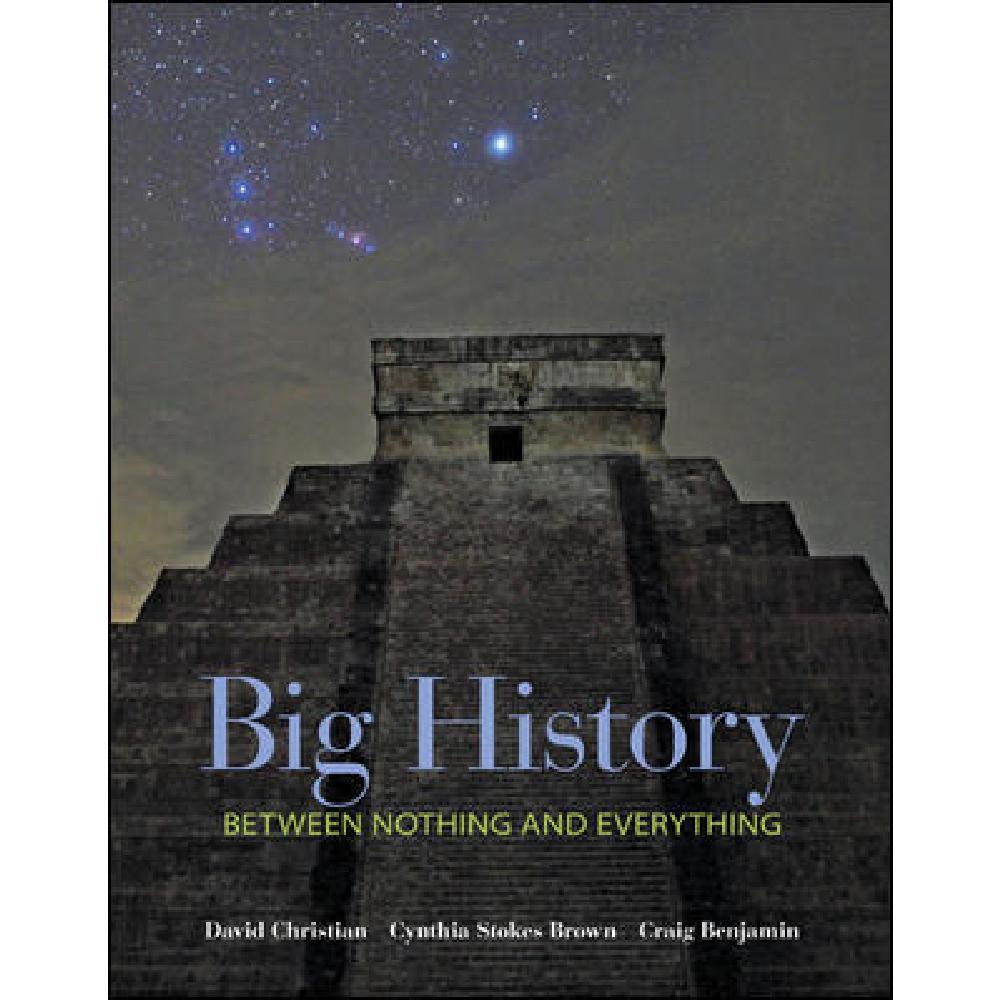Chapter 11: Breakthrough to Modernity
True/False
1. The rationale for considering the Industrial Revolution as the eighth threshold lies in the swift transformation that it caused in human societies.
Answer: True
Page: 244
Explanation: The rationale for considering the Industrial Revolution as the eighth threshold lies in the swift transformation that it caused in human societies; they were fundamentally altered as they had not been since the breakthrough of agriculture 10,000 years earlier (the seventh threshold, also driven by a sudden increase in available energy and resources).
2. Britain and other European nations gained from China’s decision in the 1400s to use silver as the basis of its monetary system.
Answer: True
Page: 245
Explanation: Britain and other European nations gained from China’s decision in the 1400s to use silver as the basis of its monetary system.
3. The Little Ice Age was caused by a reduction in the number of volcanic eruptions and higher levels of carbon dioxide and methane in the environment.
Answer: False
Page: 246
Explanation: From about 1250 to 1900, often known as the Little Ice Age (LIA), temperatures cooled in many areas of the world. This seems to have been caused by widespread volcanic eruptions and lower levels of carbon dioxide and methane in the atmosphere.
4. The factory system was a system in which workers were brought together under supervision to work in factories where steam engines powered multiple machines.
Answer: True
Page: 249
Explanation: The factory system was a system in which workers were brought together under supervision to work in factories where steam engines powered multiple machines.
5. Over time the overall standard of living under industrialization fell for both men and women.
Answer: False
Page: 262
Explanation: Over time the overall standard of living under industrialization rose for both men and women as control of resources rose faster than increases in population.
Multiple Choice
1. Which of the following is an example of a fossil fuel?
A. Coal
B. Crude oil
C. Steel
D. Natural gas
Answer: C
Page: 244
Explanation:
Fossil fuels are coal, crude oil, and natural gas, which contain stored solar energy from millions of years ago.
2. Which of the following factors contributed to the fact that Belgium was the first to industrialize after Britain?
A. It had coal and iron deposits next to each other.
B. It mechanized silk production.
C. It had a highly-developed textile industry.
D. It lost the Crimean War.
Answer: A
Page: 250
Explanation: Belgium was the first to industrialize after Britain. It had coal and iron deposits near each other; entrepreneurs used smuggled machinery to begin businesses in Belgium.
3. _____ is the term for the expansion of industrial powers and the conquest and colonization of African, Latin American, and Asian societies by the industrialized nations.
A. Capitalism
B. Nationalism
C. Imperialism
D. Democracy
Answer: C
Page: 255
Explanation: During the nineteenth century most of the people in other parts of the world had to deal with the reality of the new power of industrialized societies—that is, with some kind of U.S., European, and Japanese imperialism, the term for the expansion of industrial powers and the conquest and colonization of African, Latin American, and Asian societies by the industrialized nations.
4. By the early 1800s Americans were involved in the opium trade, using sources grown in _____.
A. Egypt
B. China
C. India
D. Turkey
Answer: D
Page: 256
Explanation: By the early 1800s Americans were also involved in the opium trade, using sources grown in Turkey.
5. Native-born people without a well-defined state structure are known as _____.
A. settler populations
B. foreigners
C. monocultures
D. indigenous peoples
Answer: D
Page: 263
Explanation: During the nineteenth century three global losses loomed large—the loss of forests, of animals, and of indigenous peoples, defined as native-born people without a well- defined state structure.
Essay
1. What were the factors that led to the Industrial Revolution beginning in Great Britain? How did China’s decisions facilitate this revolution in Great Britain?
Unlike the agricultural revolution, which began independently in at least seven different places, the Industrial Revolution began in only one place—Great Britain. Historians and sociologists, after much discussion and argumentation, now mostly agree that a convergence of factors, both global and local, came together to produce that result.
To take off, the Industrial Revolution required at least some of these ingredients: large quantities of extra capital (money), lots of cheap labor, new markets for goods, new inventions, a new source of power, new raw materials, and an improved transportation system. In addition, changing social and ideological contexts played a significant role.
Great Britain and other western European nations such as France and the Netherlands benefited from two major decisions made by China. China’s decision to withdraw from trade in the Indian Ocean offered the British East India Company, formed in 1600, and it’s Dutch and French counterparts the opportunity to enter the markets of Southeast Asia.
In addition, Britain and other European nations gained from China’s decision in the 1400s to use silver as the basis of its monetary system. After the Treaty of Utrecht (1713), Britain gained the right to sell slaves acquired in Africa to Spanish colonies in America, in exchange for some of the vast supplies of silver being mined in Potosi, Peru (now Bolivia), and at Zacatecas, Mexico. With this silver, which the Chinese needed to provide coinage in a booming economy, the British could buy Chinese tea, silk, and porcelain in large quantities.
Behind the silver, of course, lay the primary global card in Britain’s fateful hand—the fact that, by winning the Seven Years’ War in 1763 that involved the major European countries, Britain had displaced Spain, France, and the Netherlands, to become the hub of the new Atlantic world-system of trade. This brought Britain massive raw materials and provided consistent new markets. Besides silver, the Americas provided cheap food for industrial workers (fish, potatoes, and sugar), slave-produced cotton for the textile mills, and a market for everything the colonies would need—cradles, coffins, and clothing, including that for the slaves. British entrepreneurs accumulated capital from these ventures.
In addition, the land in Britain’s North American colonies provided products that Britain could not produce on its own. By 1830 Britain’s former colonies in North America (now the United States) were producing so much cotton, sugar, and timber that Britain would have to have been twice as large to produce them. Historians Kenneth Pomeranz and Robert Marks call these American acres Britain’s “ghost acres.”
Another significant factor in pushing Great Britain into industrialization was the changing global climate. From about 1250 to 1900, often known as the Little Ice Age (LIA), temperatures cooled in many areas of the world. This seems to have been caused by widespread volcanic eruptions and lower levels of carbon dioxide and methane in the atmosphere. To keep warm people everywhere burned more wood. The British on their small island ran out of forests, which motivated them to figure out how to mine coal efficiently.
Other possible explanations for why Britain became the first site of industrialization must be summarized even more briefly. For one thing, in the sixteenth century, Spain had failed to impose its empire on Europe, despite using vast sums of silver on war. Without a unified Europe, the system of competing states and markets continued, with Britain taking dominance by winning the Seven Years’ War. Without a unified European government, neither the state nor religious institutions could dominate people’s thinking. Religious toleration and attitudes of experimentation and challenge to authority (the Enlightenment) could prevail, encouraging innovations of many different kinds. Financial institutions also developed structures for mobilizing capital.
Economic historians stress the importance of coal and colonies as the primary explanation for Britain’s dominance. Cultural historians stress the importance of particular skills, a parliamentary system that encouraged commerce, and freethinking. Important as each explanation may seem, all the forces for change interacted in complex ways, and all played out in a multicentered global arena, not just in Great Britain.
Page: 244-245
2. Discuss the social consequences of the Industrial Revolution in the colonized world.
The industrialization that occurred in Europe, the United States, Russia, and Japan in the nineteenth century affected the rest of the world profoundly. The global system of the twentieth century began to be constructed in the nineteenth century by steamships, railroads, and telegraphs. Countries that did not industrialize became producers of raw materials for those that did. Since the industrial nations needed cheap raw materials, they prodded and sometimes forced their colonies to mine ores and to produce cash crops to sell, rather than raise their traditional mixed subsistence crops to eat. The desired ores included gold, silver, copper, tin, and diamonds; the desired cash crops included increased harvests of coffee, tea, and sugar, as well as cotton, cocoa, peanuts, palm oil, tropical fruits, rubber, and hemp. Raising these crops resulted in land redistribution, local famines, and the cutting of forests for new land to cultivate. Huge plantations developed, financed by Europeans, where impoverished workers came from great distances and grew sugarcane, rubber, tea, tobacco, and hemp, suffering disease rates twice those of the colony itself.
As European nations took over colonies, directly or indirectly, violence was a prominent feature, both during the conquests and afterward. But cooperation also took place, as Europeans had to depend on local elites to act as intermediaries in carrying out government functions. Indian princes, African chiefs, and Muslim emirs found ways to retain their status and privileges, reinforcing traditional class structures.
With Europeans came their systems of values, through the work of government servants, missionaries, and volunteer services. Government and missionary schools provided some local people an opportunity for a Western education and access to better-paying jobs in government, mission organizations, and business fi rms. Both Roman Catholic and Protestant missionary work increased significantly in the nineteenth century. The campaigns in England for abolishing slavery initiated mission activity in West Africa and then throughout the British Empire. Roman Catholic missionary activity reemerged in France after 1815, with
Catholic missions attempting to protect native people in the Amazon after 1850. By 1910 more than 10,000 missionaries had entered Africa alone.
Yet as Europeans sought to spur education in their colonies, they also constricted it by their racial fears. In East Africa, Europeans regularly called African men “boys.” They rarely permitted even highly educated Asians and Africans to enter the higher ranks of the colonial civil service. In places with much permanent white settlement, such as South Africa, Europeans set up systems of strict racial segregation, with separate “homelands,” public facilities, and educational and residential areas. In India the British reinforced the traditional caste system, scorning as “non-Indian” the more egalitarian views of the new Indian elite educated in European schools.
Many colonial people chose not to cooperate with the colonizers, and sometimes open rebellions erupted. The most famous of these revolts were the Indian Rebellion of 1857 to 1858 and the two peasant revolts in China, the Taiping Uprising (1850–64) and the Boxer Rebellion (1899–1901) mentioned earlier.
The Indian Rebellion (called the Indian Mutiny by the British) began when the British introduced a new cartridge smeared with cow and pig fat as a lubricant. Cows were sacred to Hindus, and pigs were offensive to Muslims; both groups saw the innovation as an attempt to convert them to Christianity. Indian troops in Bengal mutinied to initiate the rebellion, which spread to other regions and social groups. British authorities crushed the rebellion and afterward took direct control of India, ending the rule of the British East India Company.
Migrations, which were broadly similar to the trans-Atlantic ones in size and timing, also took place across the nonindustrial world. From India and southern China, many people migrated to Southeast Asia, the Indian Ocean Rim, and the South Pacific. From Northeast Asia and Russia, many moved to Manchuria, Siberia, Central Asia, and Japan. Long-distance and transoceanic migration increased gradually from the 1820s, then increased dramatically in the last quarter of the nineteenth century, facilitated by the growth of railroads and steamships. Non-Europeans were as greatly involved as Europeans in the expansion and integration of the world economy.
Page: 262-263













Reviews
There are no reviews yet.